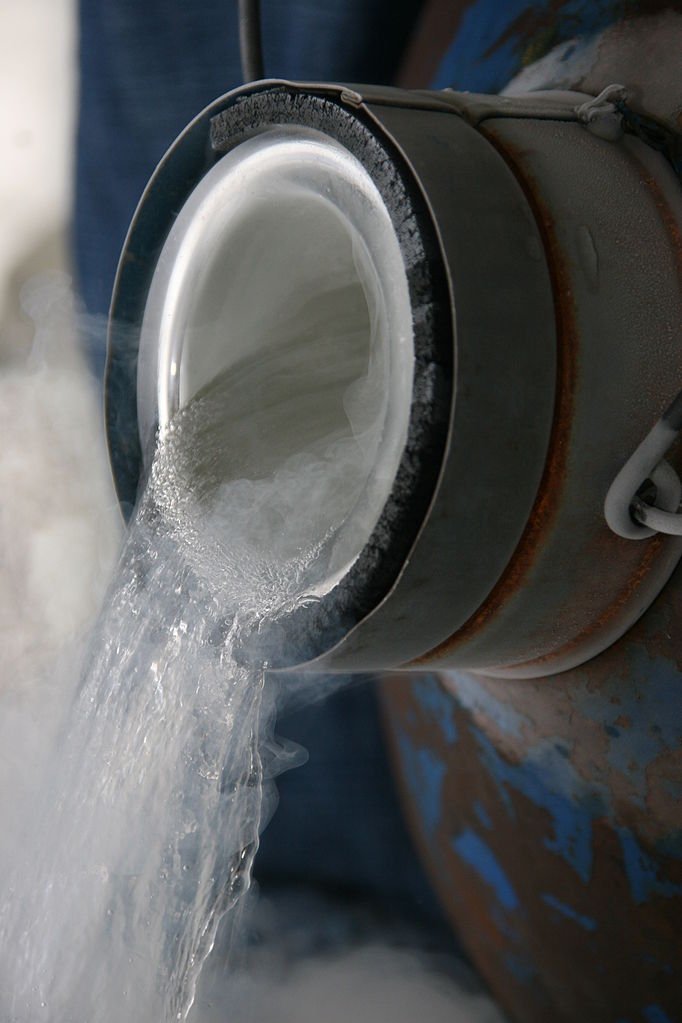12 April 2024
Nitrogen is the chemical element with atomic number 7 and the symbol N. It is the most common element in the earth’s atmosphere. The English name is borrowed from French, which formed it as a combination of nitre and ‑gène. The latter lexeme is from the Greek -γενής (-genes), meaning that which produces. Nitre, however, came to French from the Latin nitrum, which Latin acquired from the Greek νίτρον (nitron), which in turn comes from a Semitic root, possibly the Egyptian ntrj, that signified the divine or sacred. Sodium carbonate, or natron, is a drying agent that was used in mummification. So nitrogen is literally that which produces nitric acid.
The first to recognize nitrogen as a distinct gas was Daniel Rutherford in 1772. He called it mephitic air (noxious air):
Per Aërem Mephiticum, quem alii vocant Fixum, intelligo, cum Cl. Prof. Black, singularem istam aëis speciem, quae animalibus lethum infert, quae ignem aut flammam extinguit, et quae a calce viva ac salibus alkalinis avidissime attrahitur.
(By the [term] Mephitic Air, which others call Fixed, I understand, along with Prof. Black, that particular species of air which brings disaster to animals, which extinguishes fire or flame, and which is most eagerly attracted by quicklime and alkaline salts.)
Of course nitrogen is not toxic, and flames are extinguished and animals die not from the nitrogen, but from the lack of oxygen in pure nitrogen environments.
Besides mephitic air, another early name for nitrogen was azote. That term was coined by Louis-Bernard Guyton, Baron de Morveau in 1787:
Dans ces circonstances nous n’avons pas cru pouvoir mieux faire que de nous arrêter à cette autre propriété de l'air phlogistiqué, qu’il manifeste si sensiblement, de ne pas entretenir la vie des animaux, d’être réellement non-vital, de l’être, en un mot, dans un sens plus vrai que les gaz acides & hépatiques qui ne font pas comme lui partie essentielle de la masse atmosphérique, & nous l’avons nommé azote, de l’ɑ privatif des grecs & de ζωή vie. Il ne sera pas difficile après cela d’entendre & de retenir que l’air commun eft un composé de gaz oxigène & de gaz azotique.
(In these circumstances we did not believe we could do better than to focus on this other property of phlogistoned air, which it manifests so noticeably, of not supporting the life of animals, of being truly non-vital, to be, in a word, in a truer sense than the acid and hepatic gases which do not, like it, form an essential part of the atmospheric mass, and we have named it azote, from the privative ɑ of the Greeks and of ζωή life. After that, it will not be difficult to understand and remember that common air is a compound of oxygen gas and azotic gas.)
The name nitrogen, or rather nitrogène in the original French, was coined by Jean-Antoine Chaptal in 1790:
Il me paroît donc, que la dénomination gaz azote n’eft point établie d’après les principes qu’on a adoptés, et que les noms donnés aux diverses substances dont ce gaz forme un des élémens s`éloignent également des principes de la nomenclature. Pour corriger la no menclature sur ce point, il n’est question que de substituer à ce mot une dénomination qui dérive du systême général qu’on a suivi, et je me permettrai de proposer celle de gaz nitrogène: d’abord elle est déduite d’une propriété caractéristique et exclusive de ce gaz qui forme le radical de l’acide nitrique.
(It therefore appears to me that the name azote gas is not established according to the principles that have been adopted, and that the names given to the various substances of which this gas forms one of the elements also move away from the principles of nomenclature. To correct the nomenclature on this point, it is only a question of substituting for this word a name which derives from the general system that we have followed, and I would allow myself to propose that of nitrogen gas: first of all it is deduced of a characteristic and exclusive property of this gas which forms the nitric acid radical.)
Sources:
Chaptal, Jean-Antoine. Élémens de Chimie, vol. 1. Montpellier: Jean-François Picot, 1790, lx–lxi. HathiTrust Digital Library.
De Morveau, Louis-Bernard Guyton. “Le Mémoire sur le Développement des Principes de la Nomenclature Méthodique.” In Louis-Bernard Guyton de Morveau, Antoine Lavoisier, Claude Louis Bertholet, and Antoine-François de Fourcroy. Méthode de Nomenclature Chimique. Paris: Cuchet, 1787, 26–74 at 36. Eighteenth Century Collections Online (ECCO).
Miśkowiec, Pawel. “Name Game: The Naming History of the Chemical Elements—Part 1—From Antiquity till the End of 18th Century.” Foundations of Chemistry. 1 November 2022. DOI: 10.1007/s10698-022-09448-5.
Oxford English Dictionary, third edition, December 2003, s.v. nitrogen, n.; second edition, 1989, s.v. azote, n.
Rutherford Daniel. Dissertatio inauguralis de aere fixo dicto, aut mephitico. Edinburgh: Balfour and Smellie, 1772, 3. Eighteenth Century Collections Online (ECCO).
Photo credit: Robin Müller, 2011. Wikimedia Commons. Used under a Creative Commons Attribution-Share Alike 3.0 Unported license.

